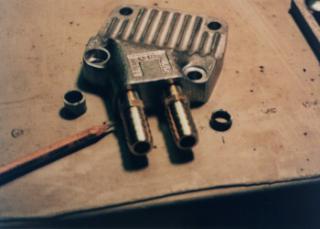 In August of 2000 I bought a Bugpack oil pump that takes a normal, screw-on oil filter. This is a lot simpler than an external oil filter.
In August of 2000 I bought a Bugpack oil pump that takes a normal, screw-on oil filter. This is a lot simpler than an external oil filter.The pump has a pressure relief valve built in, and 30mm gears.The pump was fine, but I have issues with Bugpack quality. I found metal slivers in the pump, although these may have come from a bad "rebuilt" engine that I was sold. The gears had small machining burrs which I carefully removed with a file. I think Bugpack should be able to sell a pump that doesn't need cleaning up before installation. The instructions were not as useful as I think they should be.
It's a nice pump. I'd recommend it, but you should shop around to see if you can get better quality elsewhere. I just put one on my new engine!
Why does the pump need a built in pressure relief? With 26 mm stock gears and some luck, you might get away with no extra pressure relief.
However, with 30 mm gears there's a lot more flow. When the temperature drops (as it does in Virginia winters) the oil is thicker and outlet oil pressures at the pump can be very high.
What about those metal chips? I'm not sure they were in the pump but always, always, clean new engine parts before installing them. This is especially true of anything that has been machined, or has thread cut into it. New parts shouldn't have metal flakes, but they often do, and that's just reality. I recommend that you try to get higher quality parts without this problem, but that might not always be practical, or affordable.
What about pump studs? This pump shipped with bolts. This seems to be bad idea. Someone wrote that bolts are used on aircraft VW applications. I have no idea if that's true, but VW puts studs in at the factory. If Bugpack thinks cap-head bolts are superior to studs, then the instructions with the pump should explain that. The instructions were very terse.
In order to use the factory torque settings you have to use studs. The bolt torque settings might be close, but the VW shop manual torque values are for nuts on studs. Torque values for bolts will be slightly different. Just go to your nearest specialty fastener store and get longer studs. Just make sure they don't protrude inside the case and hit the cam (again, someone wrote to tell me it is impossible for them to protrude; maybe that is true, but check to make sure.) Also make sure that they clear the engine tin and main pulley. You may have to cut the studs. That's OK. My specialty fastener guy (who supplies all the odd-ball hardware I need) says that metric threaded rod will work just fine. While you are at the store, get a couple dozen wavy washers.
On my old engine I installed the CB Performance Maxi-pump 3 which has 26 mm gears. This is the same as stock late model. (what's the difference between this and the Maxi-pump 4?). It allows for full flow filtering without tapping or modifying the case. It has the late model stock 26 mm gears (not the heavy duty 30 mm gears). Oil hose and filter adapter are Bugpack parts.
This job was a bear. I really needed the oil pump puller and pulley puller. I loosened a couple of case nuts on either site of the oil pump. I ended up tapping on a screwdriver on the edges of the pump to drive the pump rearward. I did alternate sides. Not recommended. I bent a stud with a stud removal tool: also not recommended. Just use two nuts tightened against each other to remove studs. CB Performance supplies some allen head screws. It turns out that these don't go into the case nearly as far as the studs you just removed. So, I only removed two studs, and replaced them with some longer studs.
I had to make spacers to go under the nuts, since the oil pump cover plate was explicitly designed for allen head screws.

